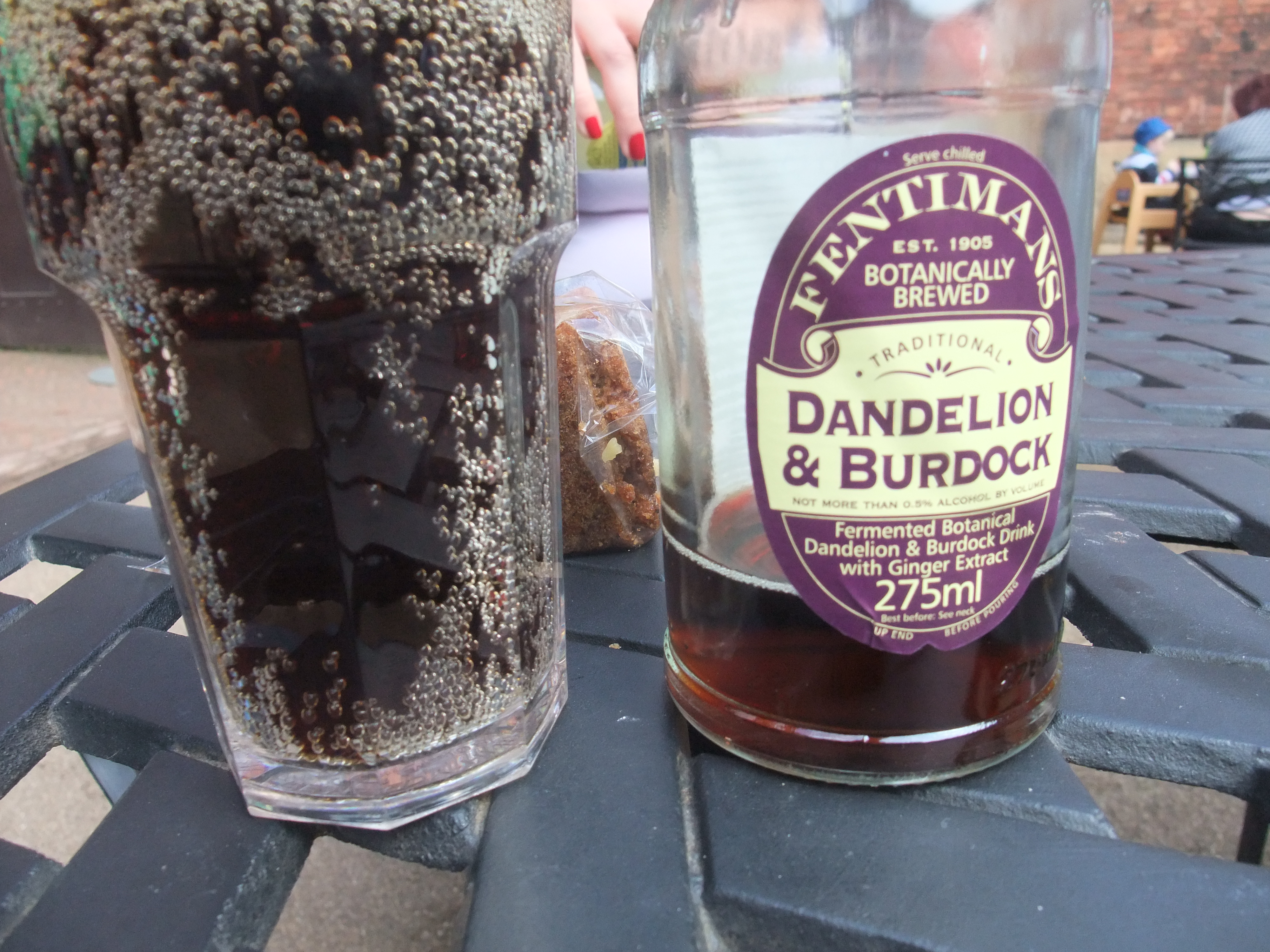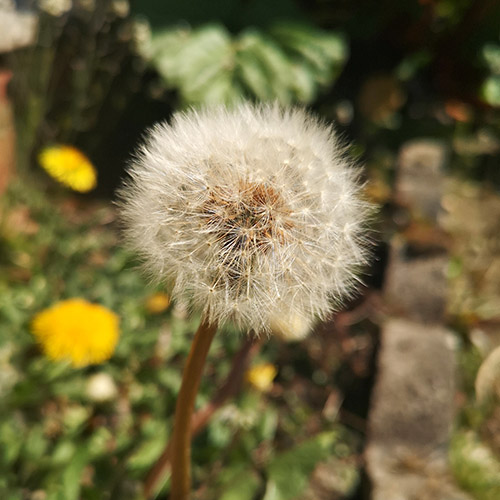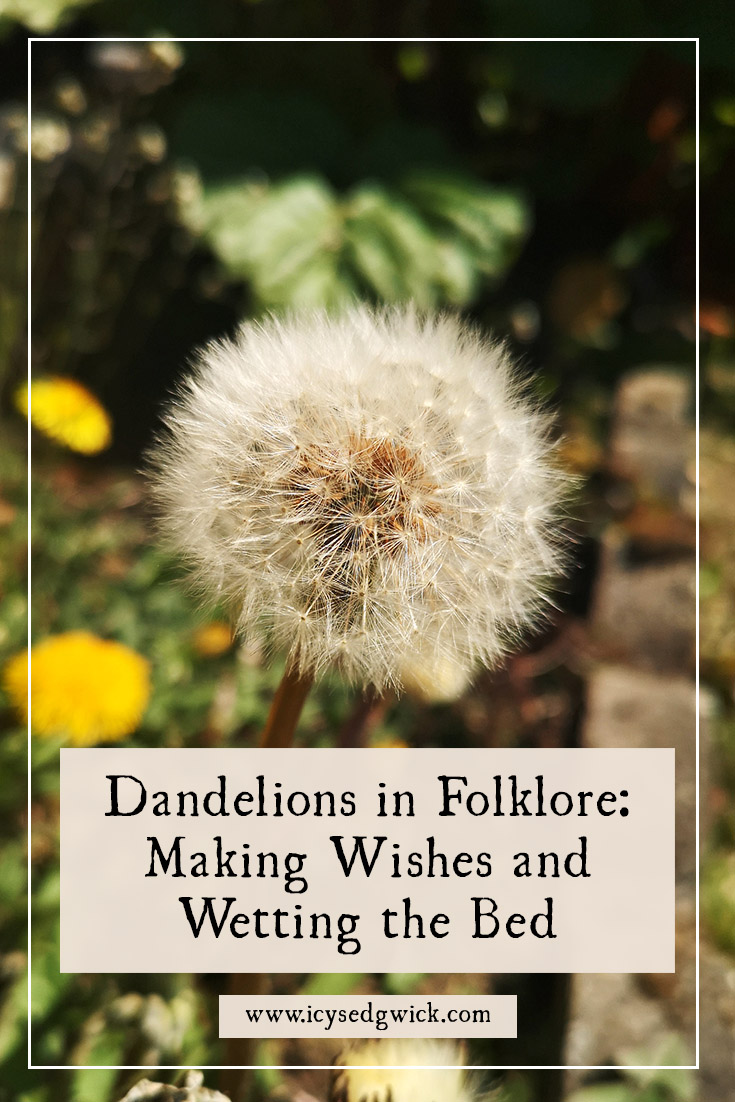Dandelions are cheerful little splashes of colour in lawns and borders. They flower longer than any other plant, providing food for early pollinators. Sadly, not everyone loves them as much as I do. They’re often considered weeds, and are somewhat unwanted plants.
But remember. Weeds are just flowers that grow where we don’t necessarily want them to.
Still, they’ve grown up alongside us here in the British Isles so there’s naturally plenty of folklore about these sunshine plants. Let’s find out how we can use them to make wishes, cure warts, and predict the weather…
Names
The name ‘dandelion’ comes ‘dents de lion’ in French, referring to the way the pointed leaves resemble the teeth of lions (Gray 2015: 103). It’s also called Bearnan Bride in Gaelic, which means ‘little notched plant of Bride’ (Baker 2011 [1969]: 50). This refers to the ways in which the plant is associated with St Brigid. It’s also known as, among other things; cankerwort, priest’s crown, puffball, swine’s snout, wild endive, Irish Daisy, milk-witch, and yellow gowan (Dietz 2020: 214).
Varied Uses
While many people nowadays see them as a weed, they’ve been used in both medicine and cooking for centuries. Note its botancial name Taraxacum officinale. The word ‘officinale’ tells us it was once kept in an officina, or storeroom, by monks, meaning they used it for medicinal purposes.
The leaves are edible so you can put them in a salad. You can make both honey and wine using the flowers, and people have dried and ground the root to use as a coffee substitute. Margaret Baker notes its roasted roots were used to make coffee until 1914. In Cambridgeshire, people made dandelion wine, and gathering the flowers on May Day apparently improved its quality (Baker 2011 [1969]: 50). A Plant-Lore.com respondent noted that dandelion wine was good for kidney problems and indigestion (Plant-Lore 2021).
Farmers would encourage dandelions in their orchards since they give off ethylene gas, which helps to ripen fruit (Baker 2011 [1969]: 50).
But wait, there’s more!
Not only that, but their sap is even useful. It takes 12 hours to dry, so trackers can use it to figure out when an animal last used a trail. Even more, you can spread the sap into a thin line and use it in place of a rubber band once it dries (Inkwright 2019: 61). Fez Inkwright notes that you can use the juice from the stems to soothe blisters, bee stings, and warts (2019: 63). Respondents on Plant-Lore.com noted this wart-busting ability of dandelion sap, and report that it actually worked.
Inkwright recommends harvesting the stems, leaves and flowers between May and August. Harvest the roots between November and March (2019: 63). That said, if you’re interested in learning more about herbalism and how to make your own potions from what grows in your garden, I highly recommend the courses from Rowan + Sage. I’m currently working through Kitchen Herbcraft, and you can come join me in class here!
Dandelion and Burdock
I remember drinking dandelion and burdock as a child, but I have no idea how much of either plant it actually contained. Nor do I know if it was actually useful for anything!
The original drink dates back to the Middle Ages, commonly drunk in the British Isles, and once a form of light mead. Its name came from the fact people made it with fermented dandelion and burdock. Nowadays, it’s a fizzy soft drink.
Fentimans, the drinks company that make naturally brewed drinks, makes a form of dandelion and burdock that uses plant extracts. It’s still a far cry from the original.

Predicting Weather and Making Wishes
Dandelions are fascinating because they open and close according to light levels. They’re also believed to close if rain is coming, which could explain why they’re called the “rustic oracle” in the language of flowers (Burke 1858: 19). If the seeds fall from the head on a still day, it also means rain is on the way (Inkwright 2019: 61). If you buried a dandelion seed head in the northwest corner of your house, it would bring desirable winds (Dietz 2020: 215).
Dandelions also have two distinct stages – the bright yellow flowers, which represent the sun, and the fluffy seed head, which represents the moon. Samantha Gray notes that its seeds represent the stars when they scatter into the air (2015: 103).
Perhaps the most obvious folklore association with dandelions links them with wishing. If you blow on the seed head, thus dispersing its seeds for the plant, you should make a wish. Be careful if you engage in this practice. One belief explains that if all the seeds come loose at once, the child’s mother doesn’t want him. If a few remain after the first blow, the child should hurry home (Baker 2011 [1969]: 50).
Others thought that you only got a wish if you blew all the seeds off a seed head. That said, there was also a belief that if you blew the seeds off the seed head, you’d live for as many years as there were remaining seeds (Dietz 2020: 215). Various respondents on Plant-Lore.com noted the ‘time-telling’ qualities of the dandelion. You blew on the seed head. However many tries it took to dislodge all the seeds told you what hour it was (Plant-Lore 2021).
You could also picture a message to a loved one, and then blow on a seed head in their direction to send them the message (Dietz 2020: 215).
Meanwhile, people in Aberdeen called the fluffy seeds ‘hairy witches’. Catching one brought good luck, and you could make a wish on it (Plant-Lore 2021). So you didn’t have to be the one to blow on the seed head to get the benefit of it!

Bedwetting
Their other main association is with its diuretic qualities, which explains one of its folk names of ‘wet the bed’ or ‘piss-a-bed’. If a child sniffed a dandelion on May Day, they wouldn’t wet the bed for a year (Baker 2011 [1969]: 50). These qualities aren’t necessarily a bad thing – in the 19th century, people used the leaves and roots in medicines designed to flush out the kidneys (Binney 2018: 118).
On Plant-Lore.com, one respondent noted you picked dandelion seed heads to tell the time, but you left the flowers alone, otherwise, you’d wet the bed. Someone else said it was okay to touch dandelions before 4 pm, but doing so after 4 pm would make you need the toilet all night (Plant-Lore 2021). There seemed to be much discussion about children picking the plants and trying to hit each other with the flower or leaves to make each other wet the bed. It seems being touched with the flower did absolutely nothing.
I should also point out that I used to pick dandelion leaves all the time for my pet rabbit. He lived in the house but he loved dandelion leaves as a handy snack. I certainly never wet the bed.
Flower Associations
The dandelion has also had two separate associations in its time. Its links with the sun meant it once represented happiness, faithfulness, and loyalty – much like a lion, I suppose.

But the Victorians in England found its flower a little too cheerful, and decided that it actually represent coquetry instead. If you dreamt of dandelions, it meant your loved one was lying to you (Gray 2015: 103). What utter killjoys the Victorians were.
What do we make of dandelions?
It’s sad that dandelions have ended up being classified as a weed, purely because they grow quickly and put down very long, strong roots. We can use each part of the plant, and pollinators need them in early spring.
Perhaps it’s precisely because dandelions are so safe that they’ve ended up so strongly associated with children. It is this childlike link between the plant and making wishes, or bedwetting, that seem to have overshadowed the coquettish associations added by the dandelion.
But one thing is for sure. They may not be as flashy as the foxglove, or as a dangerous as the hellebore, but at least they’ll brighten up your garden without causing you harm!
Do you like the humble dandelion, or do you consider it a weed? Let me know below!
References
Baker, Margaret (2011) Discovering the Folklore of Plants, 3rd edition, Oxford: Shire Classics (affiliate link).
Binney, Ruth (2018), Plant Lore and Legend, Hassocks: Rydon.
Burke, Anna (1858), The illustrated language of flowers, London: G. Routledge & Co.
Dietz, S. Theresa (2020), The Complete Language of Flowers: A Definitive and Illustrated History, New York: Wellfleet Press (affiliate link).
Gray, Samantha (2015), The Secret Language of Flowers, London: CICO Books (affiliate link).
Inkwright, Fez (2020), Folk Magic and Healing: An Unusual History of Everyday Plants, London: Liminal 11 Press.
Plant Lore (2021), ‘Dandelion’, Plant-Lore.com, https://www.plant-lore.com/dandelion/.
Nutty about folklore and want more?
Add your email below and get these posts in your inbox every week.
You'll also get my 5-step guide to protecting your home using folklore!










No problems having dandelions in my lawn,. They are green, same as the grass, and the flowers are pretty. No sense poisoning the environment to get rid of them (My Mom used to dig them up and cook them, and various friends have made wine from them.)
Will you do an episode on Bluebells?
I’ve already got one! https://www.icysedgwick.com/common-garden-flowers/
Lovely!
Dandelions are essential for early pollinators, and I love seeing them in the lawn. You can make wine or jelly from them as well, the jelly apparently has a honey-like taste.